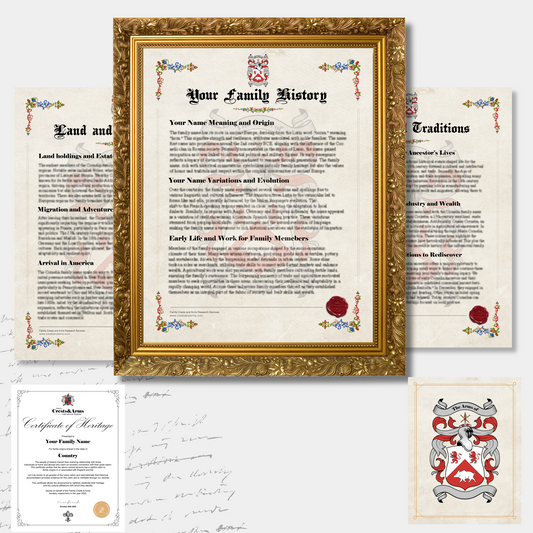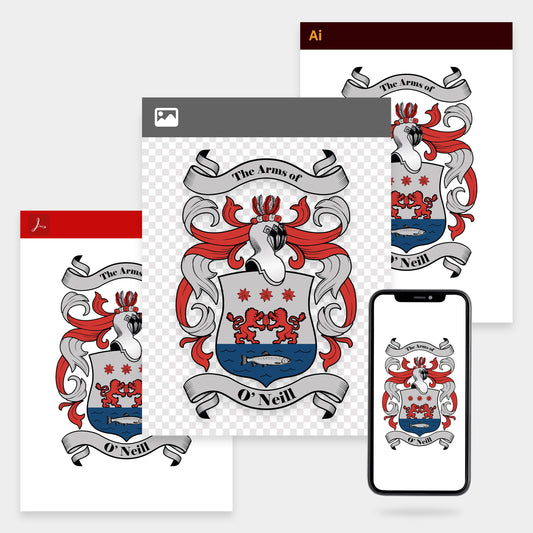Discover the O'Brien family crest and history

Official O'Brien family crest
The original O'Brien family crest is dominated by a rich red color, or 'The Martyr's color', which signifies military fortitude - symbolism representing the long standing warrior history of the O'Briens in Ireland (see below).
Whites and pale greys represent the peaceful and sincere nature of the O'Brien family in ordinary times, while the iconic three lions in gold & silver symbolise the 'deathless courage' of family members in times of hardship.
The sword-wielding arm is a connection to Naudu, a mythical Irish king who reclaimed his throne with a false arm after being injured in battle - a faith shared by the O'Brien's founding family member.
Read our short history of the respected O'Brien family on this page or connect with your ancestors through our expertly researched family crest products.

Origins and a short history of the O'Brien family
Perhaps the most famous and long established family name in the history of Ireland, the O'Brian/O'Brien name holds a rich heritage on the Emerald Isle.
The name comes from the old Gaelic name Ó Briain, translated as descendant or son of Brian, relating to the famous and powerful Brian Boru, a man widely regarded as the greatest of all the high kings in medieval Ireland.
Boru originally gained significant power in the modern Irish counties of Clare and Limerick before defeating and killing the king of Munster in 978. The most iconic historical event in the O’Brian family history was the battle between Boru’s forces and the King of Leinster. It was here in 1014 that Boru defeated an ambushing combination of Leinster forces and the Dublin Vikings at the battle of Clontarf. Brian himself was ultimately killed in the battle but the victory is recognized as a pivotal event in driving Viking forces from Ireland.
During the Tudor conquests of Ireland, the O’Briens received titles such as Viscount of Clare and Earl of Thomand in exchange for their support of King Henry VII, with Murrough O’Brien finally relinquishing his royal status to King Henry in 1543.
Most emigration of the O’Brien’s occurred in the 1800s with many family members moving to America, Canada, New Zealand and Australia, all of which still see the family name in the top ten most popular surnames.
While there are many variations in the spelling of the O’Brian name, all can be traced back to the same origins. The spelling variations are in large part due to emigrants leaving Ireland in the 1800 and 1900’s with the name being transcribed incorrectly as the ‘Ó Briains’ arrived in ports around the world. Many Gaelic names were also anglicized in the 19th and 20th century as it was considered politically or socially advantageous to do so.
Variations include: O’Bryen, O’Bryan, Brain, Bryan, Bryant, Brien, Briant and Bryans, McBrien, McBrine, Briand, Brine, Brines, Briens and many more.
Hand-Crafted in Ireland - Shop Personalized O'Brien family crest products
Made in Ireland - Explore our framed or unframed prints of the O'Brien family crest and history. Featuring single crests, crests for couples and much more. For all product types and gifts, please enter our full collection via the links below.
Shop our bestsellers
-
Research + Family Crest Print
Regular price From $33.00 USDRegular priceUnit price per$54.00 USDSale price From $33.00 USD Sale
Sale -
Premium Crest & History Package
Regular price From $199.00 USDRegular priceUnit price per
-
Research + Double Crest
Regular price From $49.00 USDRegular priceUnit price per$54.00 USDSale price From $49.00 USD Sale
Sale -
Digital Crest Files
Regular price $33.00 USDRegular priceUnit price per$49.00 USDSale price $33.00 USD Sale
Sale




